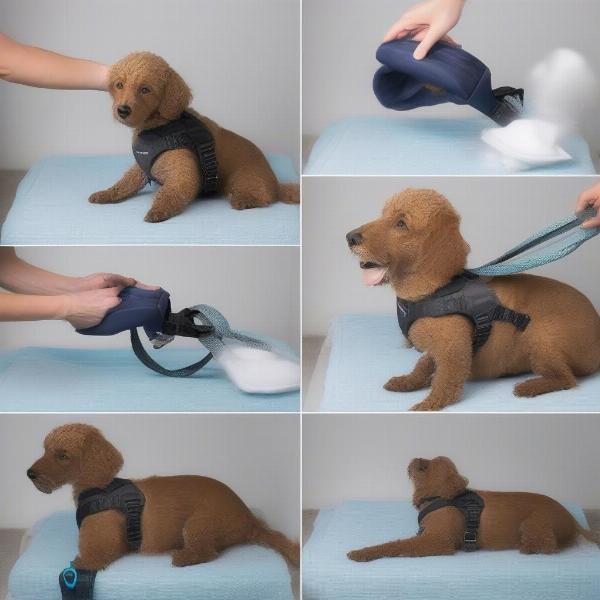A padded dog harness offers superior comfort and protection for your canine companion compared to traditional collars, especially during walks, runs, or car rides. Whether you have a tiny Chihuahua or a burly Great Dane, understanding the benefits and features of a padded dog harness is crucial for responsible dog ownership. Choosing the right harness can significantly improve your dog’s walking experience and prevent injuries. This article will delve into the world of padded dog harnesses, helping you select the ideal one for your furry friend’s needs.
Why Choose a Padded Dog Harness?
Padded dog harnesses distribute pressure evenly across the chest and back, minimizing strain on the neck and trachea. This is especially beneficial for dogs prone to pulling, coughing, or breathing difficulties. Unlike collars, which can put pressure on sensitive areas, a padded harness provides a more comfortable and secure fit. The added padding also prevents chafing and rubbing, making it ideal for dogs with sensitive skin or those who enjoy extended walks or runs. Plus, a well-fitted padded dog harness offers better control, making training easier and walks more enjoyable.
Different Types of Padded Dog Harnesses
There’s a wide array of padded dog harnesses available, each designed for specific needs and activities. Front-clip harnesses are excellent for training, discouraging pulling by gently redirecting the dog’s forward momentum. Back-clip harnesses are suitable for relaxed walks with well-behaved dogs. Dual-clip harnesses offer the versatility of both front and back clips, providing options for different walking scenarios. Step-in harnesses are easy to put on, especially for wiggly pups or senior dogs. No-pull harnesses are specifically designed to discourage pulling, providing gentle pressure and discouraging lunging.
How to Choose the Right Size Padded Dog Harness
Choosing the correct size is crucial for your dog’s comfort and safety. Measure your dog’s girth (around the chest, behind the front legs) and neck circumference to determine the appropriate size. Consult the manufacturer’s size chart for specific measurements. A properly fitted padded dog harness should be snug but not restrictive, allowing two fingers to fit comfortably between the harness and your dog’s body.
step in dog harness for small dogs
Key Features to Consider
When selecting a padded dog harness, consider features like adjustability, material, and reflectivity. Adjustable straps allow for a customized fit, ensuring the harness stays secure without being too tight. Durable, breathable materials like nylon or mesh provide comfort and prevent overheating. Reflective strips enhance visibility during nighttime walks, keeping your dog safe in low-light conditions.
Introducing Your Dog to a Padded Dog Harness
Introduce the harness gradually, allowing your dog to sniff and explore it before putting it on. Use positive reinforcement, such as treats and praise, to create a positive association with the harness. Start with short walks, gradually increasing the duration as your dog becomes comfortable.
Maintaining Your Padded Dog Harness
Regular cleaning is essential to keep the harness hygienic and prevent the buildup of dirt and bacteria. Most padded harnesses can be hand-washed or machine-washed on a gentle cycle. Check the manufacturer’s instructions for specific cleaning recommendations.
 Cleaning a Padded Dog Harness
Cleaning a Padded Dog Harness
Conclusion
A padded dog harness is a valuable investment for any dog owner, providing comfort, safety, and control during walks and other activities. By understanding the different types of harnesses, choosing the right size, and considering key features, you can ensure your furry friend enjoys a comfortable and secure walking experience. A padded dog harness is truly a game-changer for both dog and owner!
FAQ
- How do I measure my dog for a padded dog harness? Measure your dog’s girth and neck circumference and consult the manufacturer’s size chart.
- What type of harness is best for a dog that pulls? A front-clip or no-pull harness is recommended for dogs that pull on the leash.
- Can I use a padded dog harness for car rides? Yes, many padded harnesses have car seat attachment points for added safety.
- How often should I clean my dog’s harness? Regular cleaning, either by hand or machine washing, is recommended. Check the manufacturer’s instructions.
- Are padded dog harnesses suitable for all breeds? Yes, with the right size and type, a padded harness can be suitable for any breed.
- What material is best for a padded dog harness? Durable, breathable materials like nylon or mesh are ideal.
- Is a padded harness better than a collar? For many dogs, especially those who pull, a padded harness is a safer and more comfortable option than a collar.
About ILM Dog
ILM Dog (https://ilmdog.com) is your trusted international resource for all things dog-related. From breed selection to health and wellness, training tips to product recommendations, we provide expert advice and practical resources to help you provide the best possible care for your canine companion. Our expertise covers various areas including choosing the right breed for you, ensuring your dog’s health and wellbeing, effective training methods, proper nutrition, and finding the perfect accessories. For any inquiries or assistance, please reach out to us via email at [email protected] or phone at +44 20-3965-8624.